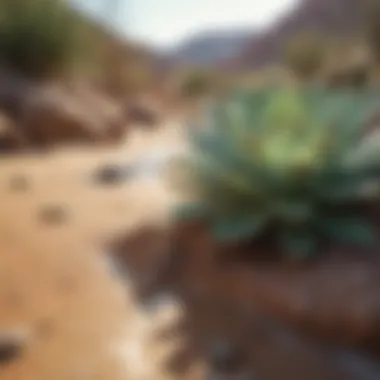Survival Strategies of Desert Flora and Fauna


Intro
Desert environments are harsh and unforgiving. Yet, life flourishes in these arid ecosystems. Both flora and fauna have developed remarkable adaptations to survive. These strategies are essential not just for individual survival, but for maintaining the ecological balance of these unique habitats. This article will explore the various adaptations of both desert plants and animals, focusing on their physiological and behavioral strategies. Each section will cover critical aspects of their survival in extreme climates and highlight recent findings in scientific research.
Fascinating Facts About the Animal
In the world of desert organisms, some animals stand out due to their unique characteristics and extraordinary abilities. These adaptations allow them to thrive where few others can.
Unique Characteristics
Desert animals often possess physical traits that enable them to combat the severe conditions of their habitats. For instance, the fennec fox has large ears that dissipate heat, helping to regulate its body temperature. Camels have specialized nostrils that can close to prevent moisture loss. Such adaptations are crucial for life where water is scarce.
Extraordinary Abilities
Some desert dwellers demonstrate remarkable abilities that permit them to utilize their environments effectively. The kangaroo rat, for example, can survive without drinking water. It extracts moisture from the seeds it consumes. This capability illustrates the ingenuity of desert adaptations, leveraging available resources to their fullest potential.
Animals in deserts exhibit unique survival strategies. These adaptations play a crucial role in managing the delicate balance of their ecosystems.
Behavior and Habitat
Understanding the behaviors of desert animals is essential for grasping how they navigate their environments.
Natural Habitats
Desert habitats vary widely—from sandy dunes to rocky plateaus. Each animal species has adapted to its specific environment, maximizing survival. Species such as the horned lizard can effectively camouflage with their surroundings, evading predators. Similarly, many reptiles utilize burrows to escape the extreme heat of midday.
Social Structures
Social structures among desert animals are varied. For example, meerkats live in complex social groups, cooperating in tasks from foraging to guarding against threats. This social behavior helps ensure survival and increases their ability to manage their challenging environment.
Recent Scientific Discoveries
Advancements in scientific research have provided deeper insights into how desert species adapt to their surroundings.
Latest Research Findings
Recent studies have revealed intricate behaviors and physiological adaptations in desert species. Research on the desert tortoise shows its ability to enter a state of dormancy during extreme droughts, conserving energy and water until conditions improve. These findings demonstrate an impressive resilience.
Breakthroughs in Animal Biology
Breakthroughs in animal biology highlight the genetic adaptations that have evolved over time. Research indicates that certain desert species possess genes that confer advantages under extreme conditions. This genetic resilience contributes not only to survival but also to biodiversity in desert ecosystems.
Cultural Significance
Desert animals hold significant places in folklore and cultural narratives around the world.
Animals in Folklore
Many desert creatures appear in traditional stories and significant cultural symbols. The coyote, for instance, is often depicted in Native American mythology, representing cunning and adaptability. This cultural significance reflects humanity's long-standing connection to these resilient animals.
Influence on Art and Literature
Desert fauna and flora have influenced various art forms. Artists have drawn inspiration from desert landscapes and its inhabitants, leading to representations that capture their unique essence. Literature also reflects themes of survival and adaptability, portraying life in the inhospitable desert.
As we continue to study and understand the remarkable adaptations of desert species, we face an important call to action. Conserving these unique habitats ensures that the intricate balance of desert ecosystems persists for future generations.
Preamble to Desert Ecosystems
Desert ecosystems offer unique insights into the resilience of life amid harsh conditions. Understanding these environments is vital for comprehending the extraordinary adaptations found in both flora and fauna. This section serves to illuminate the distinctive characteristics that define desert ecosystems and their significance for ecological studies.
Defining Desert Environments


Deserts are classified as areas that receive less than 250 millimeters of rainfall annually. They can be categorized into two primary types: hot deserts, like the Sahara, and cold deserts, such as the Gobi. The temperature extremes in these places greatly affect the organisms that inhabit them.
Deserts have a variety of physical features, including sandy dunes, rocky plateaus, and dry lakes, which shape the strategies needed for survival. The diversity in landscapes influences how plants and animals adapt to limited water sources and extreme temperatures.
Importance of Studying Desert Life
Studying desert life is essential for several reasons. First, deserts are often viewed as desolate regions; however, they are vibrant ecosystems with complex interactions between species. This misperception can lead to inadequate conservation efforts. By acknowledging the rich biodiversity in deserts, we can better focus our efforts on their protection.
Secondly, biodiversity in these ecosystems provides critical insights into adaptability and evolution. Investigating how life thrives in extreme conditions can inform broader scientific knowledge, including climate resilience and ecological balance.
In deserts, survival often hinges on the ability to cope with scarcity. Understanding these adaptations can guide efforts in preserving these delicate ecosystems.
Moreover, the study of desert life enhances our appreciation for nature's complexity. The interdependence of species illustrates broader ecological principles, essential for students as well as professionals in fields like veterinary sciences and wildlife biology.
In summary, a deep dive into the adaptations found in deserts reveals the intricate relationships that sustain life. This knowledge holds not only ecological significance but also offers insight into maintaining biodiversity in increasingly changing climates.
Flora in Desert Regions
The flora in desert regions plays a crucial role in maintaining the balance of these ecosystems. Plants uniquely adapted to arid conditions sustain wildlife, improve soil health, and contribute to the ecosystem's overall resilience. Understanding the adaptations of desert flora provides insight into the intricate relationships that define these harsh environments.
Common Desert Plant Species
Desert regions host a variety of plant species that exhibit remarkable adaptations to survive extreme heat and limited water availability. Some common species include:
- Cacti: Native to the Americas, cacti are known for their thick, fleshy stems that store water.
- Joshua Trees: Found mainly in California, these trees can store moisture in their trunk and have unique leaves that reduce water loss.
- Creosote Bush: This shrub produces a resin that helps minimize water evaporation, making it well-suited for desert life.
These plants have evolved to thrive in environments where rainfall is scarce, showing significant adaptations that allow them to exploit every opportunity for survival.
Photosynthesis in Harsh Conditions
Plants in desert regions face the challenge of photosynthesis under high temperatures and low water. Most desert plants have adapted by using a specialized form of photosynthesis known as CAM (Crassulacean Acid Metabolism).
In CAM photosynthesis, plants open their stomata at night to collect carbon dioxide and minimize water loss, storing it until daytime. This adaptation is crucial for survival, allowing plants to produce energy while effectively managing water resources.
Water Conservation Mechanisms
Water is scarce in desert environments, so plants have developed various mechanisms for conservation. Some prominent strategies include:
- Deep Root Systems: Many plants develop extensive root systems that penetrate deep into the soil to access underground water reservoirs.
- Reduced Leaf Surface Area: To minimize transpiration, some plants have small or needle-like leaves.
- Thick Cuticles: A waxy layer on plant surfaces helps reduce water loss, protecting them from the sun's harsh rays.
These methods enhance a plant's longevity in an environment where water is a limiting factor.
Role of Succulents
Succulents are perhaps the most well-known group of desert plants, characterized by their ability to store water in their leaves, stems, or roots. Succulents, like Aloe Vera and various types of cacti, have adapted to store significant amounts of moisture, helping them survive long periods of drought. Their fleshy tissues create a reservoir that can sustain the plant during dry spells.
In addition to storing water, succulents often utilize specialized forms of photosynthesis. This combination of features makes them vital contributors to the desert ecosystem, providing food and habitat for various desert fauna.
Animal Adaptations in Desert Environments
Adaptations in desert environments are fundamental for the survival of various species. The extreme conditions of these areas necessitate unique changes in the physiology and behavior of both animal and plant life. Understanding how these adaptations function provides essential insights into the biology of desert organisms. Moreover, these adaptations demonstrate the resilience of nature in the face of harsh climates, offering valuable lessons in ecology and conservation.
Physiological Adaptations
Physiological adaptations refer to the internal processes that help animals cope with arid conditions. Many desert-dwelling animals have evolved mechanisms to enhance water retention. For example, desert rodents such as the kangaroo rat do not need to drink water; instead, they derive moisture from the seeds they consume. This process minimizes the necessity for a continuous water source.
Additionally, many desert mammals possess specialized kidneys that can concentrate urine, reducing water loss. Body size can also play a crucial role; animals with smaller body sizes tend to have higher surface area to volume ratios, which can increase heat loss in cooler nights. Conversely, larger animals may retain heat during the day, which allows for prolonged activity at cooler times.
Behavioral Adjustments
Behavioral adjustments are an important aspect of survival in the desert. Many species exhibit nocturnal behavior to avoid the intense daytime heat, becoming active during the cooler nights. For instance, the common desert fox relies on this strategy to hunt for food and avoid predation.
In addition to altered activity patterns, some animals engage in burrowing to escape the heat. Ground squirrels spend substantial time underground where temperatures are lower. Furthermore, animals will often stay near sources of water or vegetation to minimize energy expenditure when foraging.


Examples of Desert Animals
Several fascinating species exemplify adaptations to desert life:
- Fennec Fox: This animal has large ears that dissipate heat effectively and enable acute hearing.
- Gila Monster: This reptile can store fat in its tail, which it utilizes during periods of food scarcity.
- Dromedary Camel: Known for its ability to survive without water for weeks, it can also tolerate high body temperatures.
- Desert Tortoise: This tortoise digs burrows to escape the heat and retains water efficiently in its bladder.
Each of these animals showcases unique traits that facilitate survival in a challenging habitat.
Predator-Prey Dynamics
In desert ecosystems, predator-prey dynamics are shaped by the adaptations of both predators and their prey. Prey species often develop defensive adaptations such as camouflage or burrowing behaviors to evade predators. The dappled coloration of many desert animals helps them blend into their surroundings, making it difficult for predators to spot them.
On the other hand, predators may evolve increased mobility or enhanced senses to effectively hunt. For example, the sidewinder rattlesnake uses its unique movement style to traverse sandy terrain quickly. The interaction between these dynamics creates a delicate balance within the ecosystem, where the evolution of one group often leads to adaptations in another.
Understanding these complex interactions is vital for conservation efforts, as changes in predator or prey populations can have cascading effects on the entire ecosystem.
In summary, adaptations in desert environments illustrate remarkable survival strategies. They reveal the intricate relationships between species and underscore the necessity for ongoing research and conservation efforts in these unique ecosystems.
Mutual Relationships Between Flora and Fauna
The interdependencies between plants and animals in desert ecosystems are critical for maintaining ecological balance. Each species contributes to the functionality and sustainability of the habitat, which is often harsh and unforgiving. Understanding how flora and fauna engage in mutual relationships can shed light on their survival strategies and can inform conservation efforts.
Pollination Strategies
Pollination is essential for plant reproduction. In desert areas, plants have adapted unique strategies to attract pollinators. Many desert plants bloom at night. Flowers such as the saguaro cactus open in the cool darkness, luring bats and certain moths. This timing reduces competition with daytime pollinators, whose activity slows during extreme heat.
Some plants, like agave, produce sweet nectar to attract specific insects and birds. The challenge is that many desert pollinators are migratory. Thus, certain plants depend on seasonal timing for their blooming cycle. Pollination ensures genetic diversity which promotes resilience in changing conditions.
- Key Pollinators:
- Bats
- Bees
- Moths
These interactions highlight a critical bond; without them, many plant species would struggle to reproduce.
Food Web Interactions
The food web in desert regions is complex and interconnected. Each species plays a defined role, with producers like cacti and grasses forming the base of the system. Herbivores, such as desert tortoises and various rodents, consume these plants, which in turn become prey for carnivores like snakes and coyotes.
In this environment, every organism depends on others, either directly or indirectly. For example, rodents not only feed on seeds but also help disperse them, promoting plant growth over a wider area.
- Food Web Dynamics:
- Producers: Cacti, shrubs
- Herbivores: Tortoises, rodents
- Carnivores: Snakes, coyotes
The delicate balance of these interactions is crucial for maintaining species diversity and ecosystem health. Changes in one part of the web can have cascading effects throughout the ecosystem.
Symbiotic Relationships
Desert flora and fauna often engage in symbiotic relationships to enhance survival. One notable example is the mutualism between certain plants and mycorrhizal fungi. These fungi extend into the soil and help plants absorb water and nutrients more effectively. In return, plants supply the fungi with carbohydrates produced through photosynthesis.
Another form of symbiosis occurs between desert ants and aphids. Ants protect aphids from predators, while benefiting from the honeydew that aphids secrete as a waste product. This interaction showcases how species adapt to thrive in challenging conditions through cooperation.
- Common Symbiotic Relationships:
- Plants and fungi
- Ants and aphids
Symbiotic relationships underscore the interconnectedness of desert life, allowing species to not only survive but thrive in a challenging environment.
The survival of desert ecosystems relies heavily on the relationships between flora and fauna. A small change in one species can affect many others, emphasizing the importance of preserving these connections.
Understanding these mutual relationships provides insights into ecological resilience and adaptation. Acknowledging the significance of these interactions can help in planning for conservation efforts, ensuring the continued survival of both flora and fauna in desert regions.
Conservation Challenges in Desert Ecosystems


The conservation of desert ecosystems is a critical topic that warrants significant attention. These ecosystems, while often overlooked, are home to unique species that have developed specialized adaptations to survive in harsh conditions. Understanding the conservation challenges faced in these areas is essential. This knowledge contributes to the preservation of ecological balance and the survival of diverse flora and fauna in desert landscapes.
Impact of Climate Change
Climate change poses a serious threat to desert ecosystems. As temperatures rise and precipitation patterns shift, the delicate balance that sustains these communities is disrupted. Many desert plants and animals are experts at surviving in specific conditions, but rapid changes can outpace their adaptability. For example, increased heat intensity can lead to more frequent droughts, affecting water availability.
- Species that rely on limited water sources face increased stress.
- Animal migrations may be disrupted, leading to challenges in finding food and habitat.
- Altered floral patterns can affect pollinators, thereby influencing the reproductive success of plants.
These changes can have cascading effects on the entire ecosystem, leading to a decline in biodiversity.
Human Activities and Habitat Loss
Human activities have dramatically altered desert landscapes. Urbanization, agriculture, and mining are just a few of the factors contributing to habitat loss. Development projects encroach upon natural habitats, fragmentation occurs, and essential resources are depleted.
- Urban sprawl results in the replacement of native vegetation with pavement and buildings.
- Agricultural practices can drain local water supplies, affecting both plants and wildlife.
Each of these factors reduces the native fauna's ability to thrive and pushes some species towards extinction. Awareness of these activities is crucial to understanding the scope of the threats faced by desert life.
Preservation Efforts
Efforts to preserve desert ecosystems are underway, though challenges remain. Organizations and researchers focus on creating conservation plans that aim to protect both flora and fauna. Key strategies include:
- Establishing protected areas to limit human impact.
- Promoting sustainable agricultural practices in desert regions.
- Implementing rehabilitation projects to restore damaged habitats.
Conservation efforts must be backed by scientific research and community involvement to be effective. The future of desert ecosystems depends on a concerted effort to address the myriad issues influencing these landscapes.
Future Research Directions
Research on desert adaptations is crucial for understanding how life exists in extreme environments. With climate change and habitat loss impacting these ecosystems, future studies can provide essential insights into adaptive strategies. Investigating these adaptations is not just about observing nature; it leads to personal understanding necessary for conservation efforts. Additionally, it can guide us in developing sustainable practices relevant to arid regions worldwide.
Technological Advances in Study
Innovations in technology have significantly improved our ability to study desert ecosystems. Remote sensing technology, for instance, offers researchers a means to analyze large landscapes without disturbing the environment. It allows for the continuous monitoring of vegetation health, soil moisture, and animal movements, yielding important data.
Moreover, techniques like DNA barcoding have advanced genetic research on desert species. We can now identify plants and animals accurately and efficiently. This process can reveal genetic diversity, critical for the survival of species under environmental stress.
Future technologies must focus on reducing human impact while maximizing data collection.
By integrating computational models, scientists can simulate various climate scenarios and their effects on desert flora and fauna. Predictive modeling can help us foresee challenges these species might face and frame strategies for adaptation and conservation.
Longitudinal Studies on Adaptations
Longitudinal studies provide a dynamic view of how desert organisms adapt over time. These studies track changes in flora and fauna amid shifting climatic conditions and human-induced changes. By observing these adaptations across multiple years or decades, researchers can gain insights into the resilience of species.
Such research can focus on:
- Growth patterns of specific plant species under varying climate conditions.
- Behavioral modifications in desert animals as temperatures fluctuate.
- Long-term impacts of reduced rainfall on ecosystem balances.
In-depth analysis allows for observing not only changes within individual species but also interactions within ecosystems. For example, understanding how the bloom periods of certain flowers shift can inform the timing of pollinator activities. This data becomes vital in preserving the ecological relationships that support these environments.
Finale
The conclusion section emphasizes the intricate adaptations of desert flora and fauna, highlighting their essential role in maintaining ecological balance. Key adaptations, from physiological mechanisms to behavioral strategies, demonstrate how these species navigate survival under extreme conditions. A comprehensive understanding of these adaptations not only informs about the unique biology of desert life but also underscores the fragility of these ecosystems.
Recap of Key Adaptations
Desert species exhibit remarkable traits suited for harsh environments. Here is a summary of the primary adaptations:
- Water Conservation: Plants like cacti store water in their tissues and have specialized structures to minimize loss. Animals, such as camels, can endure without water for weeks.
- Temperature Regulation: Many species are nocturnal, reducing exposure to harsh sunlight. For instance, the fennec fox has large ears that dissipate heat effectively.
- Drought Resistance: Plants develop deep root systems to access underground water. Some, like the creosote bush, can tolerate prolonged periods without rain and exhibit delayed germination.
- Specialized Reproductive Strategies: Many desert plants produce seeds that can lie dormant until conditions are favorable for growth, ensuring survival of the species between rare rainfall events.
Understanding these adaptations is crucial for researchers and conservationists seeking to protect these ecosystems.
Importance of Continued Research
Ongoing research into desert adaptations holds significant value. It contributes to our knowledge of biodiversity, helps in developing conservation strategies, and also aids in predicting responses to climate change. Here are key considerations:
- Biodiversity Insights: Increased understanding of how species adapt provides a clearer picture of ecosystem health. This knowledge can guide conservation efforts.
- Conservation Strategies: Research can inform effective policies to protect habitats from human encroachment and climate impacts.
- Climate Adaptability: As climate patterns shift, understanding species' resilience offers insights into potential adjustments in habitat management.
Continued exploration is essential for appreciating the delicate balance of desert ecosystems, ensuring that we can protect them for future generations.







